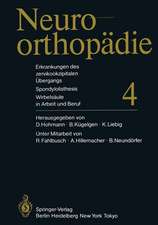Corrective Osteotomies of the Lower Extremity after Trauma
Editat de G. Hierholzer Traducere de Terry C. Telger Editat de K. H. Mülleren Limba Engleză Paperback – 16 noi 2011
Preț: 1116.73 lei
Preț vechi: 1175.51 lei
-5% Nou
Puncte Express: 1675
Preț estimativ în valută:
213.75€ • 232.26$ • 179.67£
213.75€ • 232.26$ • 179.67£
Carte tipărită la comandă
Livrare economică 21 aprilie-05 mai
Preluare comenzi: 021 569.72.76
Specificații
ISBN-13: 9783642707766
ISBN-10: 3642707769
Pagini: 436
Ilustrații: XIX, 407 p.
Dimensiuni: 210 x 280 x 23 mm
Greutate: 0.98 kg
Ediția:Softcover reprint of the original 1st ed. 1985
Editura: Springer Berlin, Heidelberg
Colecția Springer
Locul publicării:Berlin, Heidelberg, Germany
ISBN-10: 3642707769
Pagini: 436
Ilustrații: XIX, 407 p.
Dimensiuni: 210 x 280 x 23 mm
Greutate: 0.98 kg
Ediția:Softcover reprint of the original 1st ed. 1985
Editura: Springer Berlin, Heidelberg
Colecția Springer
Locul publicării:Berlin, Heidelberg, Germany
Public țintă
ResearchDescriere
The reconstructive surgery of posttraumatic deformities has made significant advances in recent years. Reports on technical progress and clinical results are encouraging, even though they have often raised patient expectations to an unrealistic level. The operative methods available to us today enable corrective osteotomies to be performed with a high degree of accuracy and success. Precisely because the sequelae of trauma are so difficult to schematize, every case must be evaluated individually based on a critical assessment of subjective complaints, diagnosis and prognosis before a decision can be made. The planning and execution of corrective procedures are carried out with the same meticulous care as for idiopathic limb deformities. However, the occurrence of a traumatizing event with its immediate and long-term complications calls for special insight in the setting of therapeutic goals. It is essential that the patient be appraised of the results that can reasonably be expected and of the risks that are involved. Success in therapeutic procedures requires detailed theoretical knowledge, thorough operative training, and a strong commitment on the part of the surgeon. It is these aspects of the corrective surgery of posttraumatic deformities with which the editors are principally concerned.
Cuprins
I. Basic Principles.- Pathophysiology of Posttraumatic Deformities of the Lower Extremity.- Indications for Corrective Osteotomy after Malunited Fractures.- Special Diagnosis and Preoperative Planning of Corrective Osteotomies.- Mechanical and Technical Principles of the Internal Fixation of Corrective Osteotomies.- Special Techniques of Internal Fixation for Corrective Osteotomies.- Summary: Principles of the Surgical Correction of Posttraumatic Deformities of the Lower Extremities.- II. The Proximal Femur.- Indications, Localization and Preoperative Planning of Proximal Femoral Osteotomies in Posttraumatic States.- Osteotomies of the Proximal Femur: Forms and Techniques.- The Intertrochanteric Osteotomy for Posttraumatic States: Reports and Selected Cases.- Results of Proximal Femoral Osteotomies Following Trauma.- Repositioning Osteotomies for Malunited Fractures Near the Hip.- Results of Corrective Osteotomies after Trauma about the Hip. Causes and Treatment of Posttraumatic Deformities.- Posttraumatic Repositioning Osteotomies of the Proximal Femur.- Summary: Surgical Correction of Posttraumatic Deformities about the Hip.- III. The Diaphyses.- Corrective Osteotomies of the Femoral Shaft.- Corrective Osteotomies of the Tibial Shaft.- The Displacement Osteotomy as a Correction Principle.- Lengthening and Shortening Osteotomies of the Diaphyses.- Complications after Corrective Osteotomies: Persistent Deformity, Nonunion, Infection.- Corrective Osteotomies of the Lower Extremity in the Presence of Infection.- Results after Surgical Correction of Posttraumatic Leg Length Discrepancies.- Summary: Corrective Osteotomies of the Diaphyses after Trauma.- IV. The Distal Femur and Proximal Tibia.- Indications, Localization and Planning of Posttraumatic Osteotomies about the Knee.- Forms and Techniques of the Supracondylar Femoral Osteotomy.- Intraligamentous Elevating Osteotomies for Posttraumatic Deformities about the Knee.- Proximal Tibial Osteotomies: Forms and Techniques.- Results of Corrective Osteotomies of the Proximal Tibia.- Results of the Intraligamentous Open Wedge Osteotomy of the Proximal Tibia (Elevating Osteotomy).- Results of Proximal Tibial Osteotomies Stabilized with the T Plate for Correction of Posttraumatic Deformity.- Results of Proximal Tibial Osteotomies Stabilized by External Skeletal Fixation.- Summary: Corrective Osteotomies after Trauma about the Knee.- V. The Ankle and Foot.- Indications and Technique of Corrective Osteotomies of the Distal Tibia and Ankle Mortise.- Statics and Dynamics of the Foot.- Corrective Osteotomies of the Foot.- Results of Corrective Osteotomies of Posttraumatic Deformities about the Ankle Joint.- Results of Corrective Osteotomies for Posttraumatic Deformities of the Foot.- Summary: Corrective Osteotomies after Trauma about the Ankle and Foot.- VI. Posttraumatic Deformity of the Growing Skeleton.- Growth Disturbance after Epiphyseal Plate Injuries.- Growth Disturbances after Injuries Outside the Epiphysis.- Indications and Techniques of Osteotomies Near Joints.- Indications and Techniques of Diaphyseal Corrective Osteotomies after Trauma.- Summary: Posttraumatic Deformity of the Growing Skeleton.- VII. Epilogue.- Changing Attitudes toward the Disabled.



















